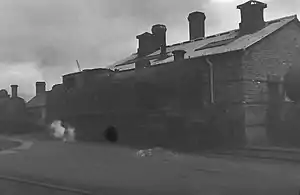BCDR 4-6-4T
The Belfast and County Down (BCDR) 4-6-4T were a class of four coupled tank locomotives build by Beyer, Peacock and Company in 1920.[4] Generally reliable and well-likely but with mediocre performance they were to spend their lives on the Queen's Quay Belfast to Bangor until withdrawal in the early 1950s. There were the only example of 4-6-4T wheel arrangement to work in Ireland apart from two examples on the narrow gauge.
| BCDR 4-6-4T | |||||||||||||||||||||||||||
|---|---|---|---|---|---|---|---|---|---|---|---|---|---|---|---|---|---|---|---|---|---|---|---|---|---|---|---|
 No. 223 at Queens Quay in 1952 | |||||||||||||||||||||||||||
| |||||||||||||||||||||||||||
| |||||||||||||||||||||||||||
| |||||||||||||||||||||||||||
| |||||||||||||||||||||||||||
| [3] | |||||||||||||||||||||||||||
History
At the end of the First World War the BCDR directories decided they would like some more powerful locomotives, and were impressed by the LB&SCR L class 4-8-4T "Brighton Baltics" on the London to Brighton line, and Petterson considered a requirement to procure a similar type imposed upon locomotive superintendent R. G. Miller.[2] When the locomotives arrived in 1920 from Beyer Peacock they were inherited by Miller's successor Crossthwait. The BCDR locomotives had smaller dimensions: 19x26in cylinders as opposed to 21x28in; driving wheels 5 ft 9 in[lower-alpha 1] as opposed to 6 ft 9 in.[2] At oven 81 tons the locomotives were noted for being very heavy.[2] They were the only locomotives of the 4-6-4 in Ireland apart from two on the narrow gauge Londonderry and Lough Swilly Railway.[2]
Allocated the numbers 22 to 25 they were to be allocated to heavy commuter trains on the 12+1⁄4 miles (19.7 km) Belfast Queen's Quay to Bangor line.[5][lower-alpha 2] In service the class was reliable but performance was mediocre and coal consumption was very high.[2] Boocock has described them as "handsome" and "well-liked" and suggests the problem may have been due to short-travel piston valves rather than drafting.[7]
The BCDR was absorbed into the Ulster Transport Authority (UTA) on 3 September 1948, the class being renumbered 222 to 225.[8][3] Class WT 2-6-4T were transferred to the Bangor line from summer 1949 and their performance was substantially better, and they began to replace the BCDR engines,[9] with UTA MED diesel railcars, the Bangor line losing all steam working by 1953.[10] Only one worked past 1952,[3] No. 222 surviving[lower-alpha 3] on the former Northern Counties Committee network with the remainder lying withdrawn at Queen's Quay sidings.[9] All were disposed for scrap in 1956.[9]
References
Notes
- Patterson & Rowledge claim the driver diameter was 5ft 9in, Bookcock claims 5ft 6in
- There was a trail train to Ballynahinch when they first arrived and one was note working in the former Northern Counties Committee network c.1953.[6]
- Boocock says No. 222 did not work after 1953 whereas Patterson does not specify a date but his prose suggests a later date.[3][9]
Footnotes
- Rowledge 1993, p. 40.
- Patterson 1982, p. 26.
- Boocock 2009, p. 99.
- Bairstow 2007, p. 14.
- Patterson 1982, pp. 26, 46–47.
- Patterson 1982, p. 26, 41.
- Boocock 2009, p. 97, 99.
- Patterson 1982, p. 40.
- Patterson 1982, p. 41.
- Boocock 2009, p. 97.
Sources
- Bairstow, Martin (2007). Railways in Ireland. Vol. Part Two:Belfast and County Down, ... ISBN 1871944333. OCLC 931393119.
- Boocock, Colin (1 October 2009). Locomotive Compendium Ireland (First ed.). Hersham: Ian Allan. ISBN 9780711033603. OCLC 423592044.
- Patterson, Edward Mervyn (1982) [1958]. Belfast and County Down Railway. Newton Abbott: David & Charles. ISBN 0-7153-8306-X. OCLC 16552845.
- Rowledge, J. W. Peter (1993). Irish Steam Loco Register. Stockport, England: Irish Traction Group. ISBN 9780947773335. OCLC 30815253.